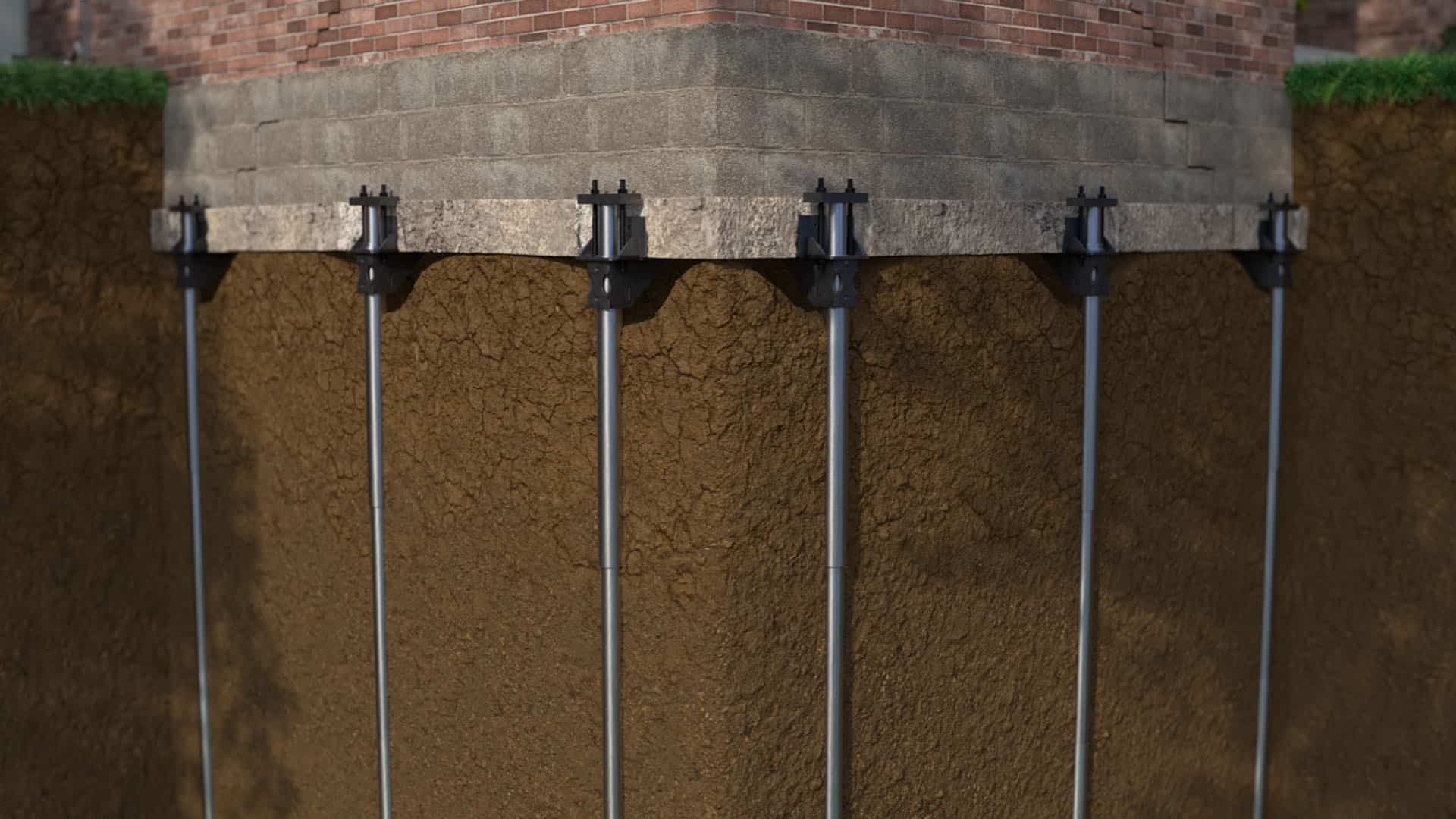
Choosing the right system for your foundation stabilization can prevent it from shifting or sinking. Understanding the difference between push piers and helical piers can help you choose the right reinforcement for your foundation. Both of these systems are designed to stabilize structures affected by foundation settlement and soil instability.
Helical piers are extremely versatile, while push piers are often more cost-effective. The most suitable foundation stabilization system for your home depends on various factors, such as property layout, soil condition, and severity of the issue.
What Are Push Piers and How Do They Work?
A push pier is a steel pole designed to stabilize a settling foundation. This system is a suitable option for your foundation if it is settling unevenly or shifting.
These piers are suitable for stabilizing heavy structures with severe foundation settlement issues. Push piers support your foundation and transfer the weight to solid ground to provide a long-lasting solution. This restores your home’s structural stability and prevents further sinking in the future.
A push pier system works by driving steel piers into the ground using hydraulic force until they reach stable soil. These piers are connected to your home’s foundation with steel brackets to transfer excessive weight to stable soil. Push piers provide long-term stability by utilizing the resistance of surrounding soil to both lateral and vertical forces.
What Are Helical Piers and How Do They Work?
A helical pier is a foundation solution designed to support your home by anchoring it deep into the ground. Helical piers are also made out of steel but look more like screws and have helical blades attached to the pier. Helical piers work effectively for a variety of soil conditions and building types. The versatile nature of helical piers makes them suitable for new construction, large buildings, light structures, and difficult-to-access foundations.
Unlike push piers, which only provide stabilization, helical piers also provide lift. This means that they can be used to lift your foundation back into its original position. Helical piers can be installed for both foundation repair projects and new construction. Even if there is not a lot of room around your foundation, helical piers can still be installed.
Key Differences Between Push Piers and Helical Piers
Here are some of the differences between push piers and helical piers:
Installation Process
- Push Piers: They are driven into the ground using hydraulic pressures until they reach bedrock or stable soil. Then, they are attached to the foundation footer with steel brackets.
- Helical Piers: These piers are screwed into the ground and attached to the house. Helical piers can be installed easily in areas with limited space without any extensive excavation. This pier is preferred by many homeowners due to its non-intrusive nature. They can also be used to lift your foundation back into place.
Structures
- Push Piers: Push piers are suitable for stabilizing sinking and shifting foundations. They are mostly used to repair structures such as homes and commercial buildings.
- Helical Piers: Helical piers are suitable for new construction projects and foundation repair. They are a suitable option for stabilizing structures built on loose or shifting soil.
Cost
- Push Piers: Push piers are the less expensive option compared to helical piers
- Helical Piers: Helical piers are more expensive. However, many homeowners prefer them because they are versatile and provide lift and support.
Pros and Cons of Push Piers and Helical Piers
Both push piers and helical piers have pros and cons:
Push Piers
Pros:
- Push piers can stabilize settled foundations by transferring the weight to stable soil.
- They are an effective solution for foundations supported by loose or shifting soil.
- Push piers are capable of supporting heavy loads and provide long-term stability.
Cons:
- Push piers are less expensive than helical piers.
- It can be challenging to install push piers in areas with limited space.
Helical Piers
Pros:
- Helical piers are minimally invasive and do not require excavation around the foundation.
- These piers are suitable for both existing foundations and new construction.
- They are quick to install and can be used in areas with limited access.
- Helical piers can also be installed in most weather conditions.
Cons:
- Helical piers are more expensive than push piers.
Common Foundation Issues That Require Pier Solutions
The foundation is the backbone of your home, and if its stability is compromised, your entire home may be impacted. Having the right pier system installed helps you protect your foundation from further damage.
Here’s a breakdown of common foundation issues and how pier systems can address them effectively:
- Misaligned Doors and Windows: A foundation causes your doors and windows to become misaligned, and they may not open or close properly. Pier systems stabilize your foundation and help realign the rest of your home.
- Sagging Floors: Sagging or uneven floors result from weakening support systems and an uneven foundation. Push piers and helical piers lift and stabilize your foundation and ensure a sturdy floor.
- Cracks in Walls or Floors: Wall and floor cracks are major warning signs of foundation issues. Installing pier systems helps you redistribute your home’s weight equally and prevent further foundation damage.
- Exterior Cracks: When your home’s foundation moves, it causes cracks in the exterior walls or brickwork. Push piers and helical piers are used to stabilize the foundation and prevent cracks in the future.
- Moisture Issues: Excessive moisture beneath your foundation can soften the soil and cause the foundation to shift. Helical piers are a suitable option for securing the foundation by transferring the weight to stable soil.
- Poor Drainage: Inadequate drainage causes the soil around your foundation to erode and leads to foundation instability. Push piers and helical piers stabilize your foundation for the long term and prevent further movement in the future.
- Soil Conditions: If the soil beneath your foundation is expansive or shifting, this can lead to severe foundation problems. Piers go deep into stable soil to provide maximum support to the foundation.
Which Pier System is Suitable for Your Home?
When you select the right pier system for your home, it helps you stabilize your foundation and prevent future issues. Whether you’re dealing with a shifting foundation or planning new construction, a pier system can help protect your property.
KC Waterproofing and Foundation Repair provides reliable foundation stabilization solutions based on your home’s unique needs. Our team inspects your foundation and provides personalized helical and push-pier installation services to provide long-lasting stability. Schedule an appointment with us today!










